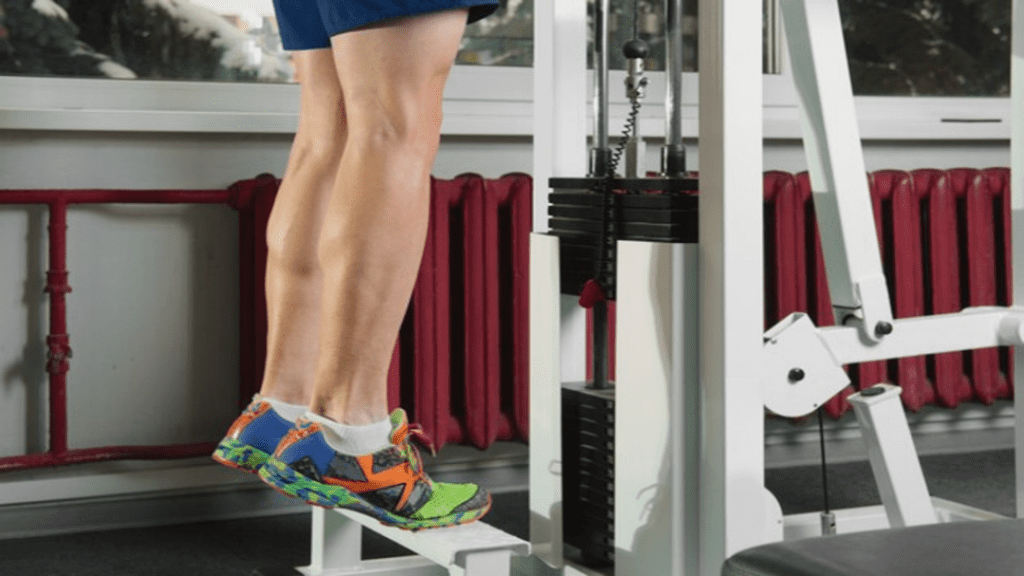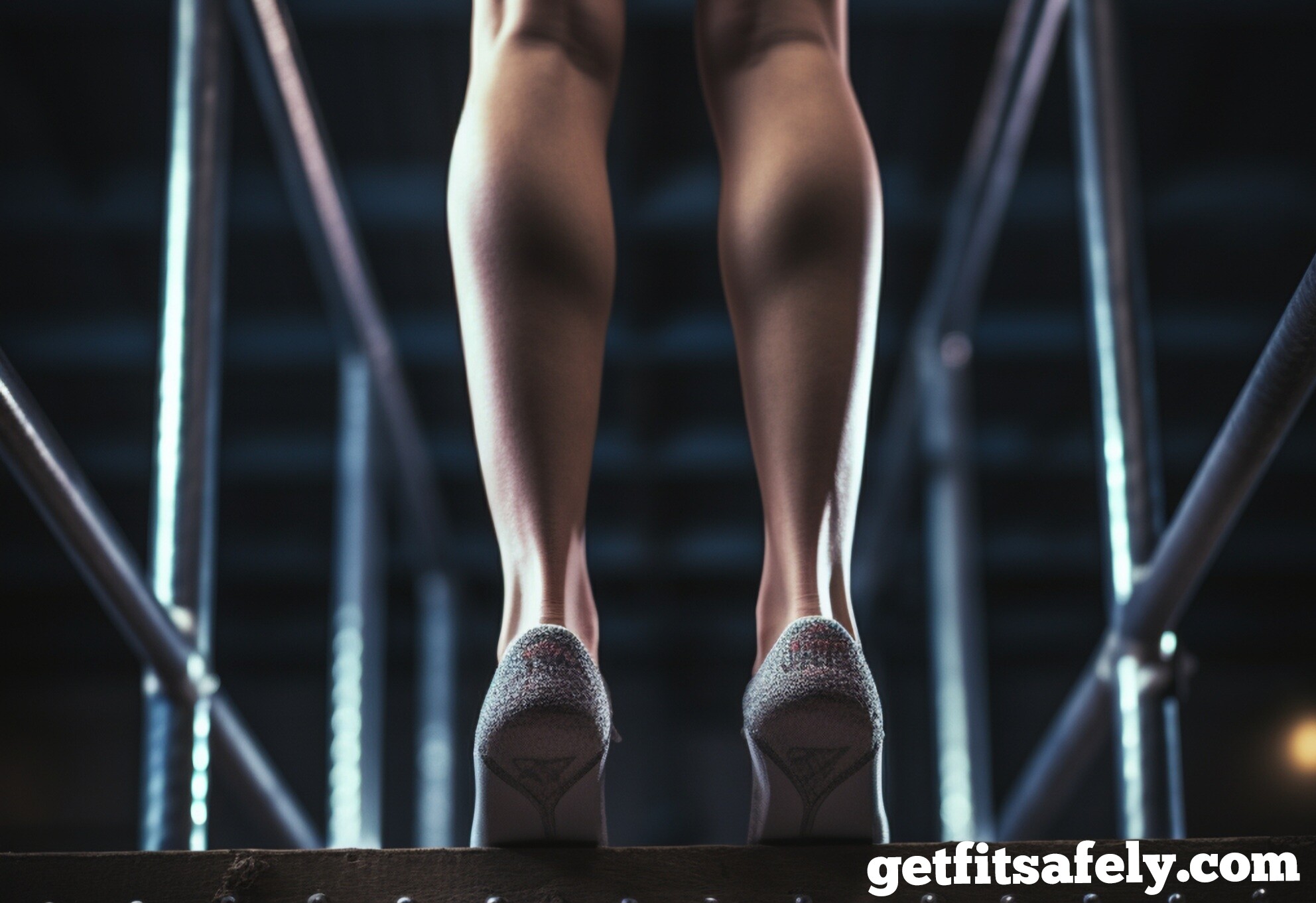In those early days, I was sure calf raises were a no-brainer.
All I needed was a Step and some effort, right?
I’d fire through sets, thinking I was on my way to building show-stopping calves.
At first, though, I couldn’t even tell if they were working my calves or not.
The answer came the next morning when I woke up with calves that felt like they’d been through a meat grinder.
Oddly enough, I noticed a faint soreness in my glutes too—nothing major, but enough to make me wonder if I was shifting my focus without realizing it.
It was confusing at first.
Over time, I learned that proper form keeps the workload where it should be and minimizes distractions from other muscles.
Now, with years of experience, I’ve pieced together exactly how to make calf raises hit hard where they’re supposed to.
Let’s break it down.
Why Do We Feel the Glutes During Calf Raises?

Early on, I assumed calf raises worked a single muscle.
But our bodies love to recruit more muscles than we expect.
As you push up onto your toes, you shift your center of gravity forward.
Your glutes, along with your core and hips, engage slightly to keep you balanced and stable.
It’s not a sign of doing something “wrong.” It’s your body’s natural balancing act.
That said, if you focus on proper execution—driving through the balls of your feet and controlling the motion—you’ll keep the effort where it belongs.
With full engagement in your calves, you might not even notice your glutes working at all.
With the right technique, the effort stays concentrated where it should, making your calves the center of attention.
Muscles Involved and Strengthened
When we say “calf raise,” we’re mainly talking about two key muscles: the gastrocnemius and the soleus.
The gastrocnemius is the big, two-headed muscle that gives your calves their shape.
Underneath, the soleus adds depth and strength, helping to stabilize the ankle and power movements like running or jumping.
These two are the stars, but they don’t act alone.
Your glutes, quads, hamstrings, and core quietly assist, ensuring you stay balanced and aligned during the motion.
Over time, training your calves doesn’t just give you well-defined lower legs.
It can improve overall leg strength, contribute to better athletic performance, and enhance balance.
You’d be surprised how something so “small” can have a ripple effect on your entire kinetic chain.
Benefits of Stronger Calves

For years, I thought calves were all about looks, but training them taught me they’re much more.
Every time I run or jump, I feel how they absorb impact and transfer power.
They’ve saved my knees and hips from unnecessary strain more times than I can count.
In the gym, I’ve found sturdy calves give me a stronger base for squats and deadlifts, making heavy lifts feel more solid.
It’s one of those muscle groups that rewards consistency in ways you might not expect.
Integrating Calf Training into Your Leg Routine
One question I’ve wrestled with is how to fit calf training into the broader landscape of a leg day.
In my early training days, I used to tack calves on at the end of a grueling workout, treating them like an afterthought.
Over time, I came to understand that if I wanted real progress, I had to give them the attention they deserved.
Some prefer hitting calves at the start, fresh and full of energy, to really prioritize their development.
Others like finishing their leg session with calf work, using it as a final polish after heavy squats and lunges.
Personally, I’ve experimented with both approaches.
If your calves are a weak point, try giving them some love at the beginning—just a few focused sets before moving on to bigger compound lifts.
On the flip side, if they’re not a priority, training them at the end can still maintain their strength and size without detracting from your main lifts.
Either way, be intentional.
Don’t let them be an afterthought if you care about results.
Proper Execution of the Calf Raise
After all this talk about glutes, stability, and programming, let’s not forget to nail the basics.
To perform a calf raise efficiently:
Stand tall, feet about shoulder-width apart, with your toes pointing forward (you can adjust this angle later for variety).
Slowly rise onto the balls of your feet, lifting your heels as high as you comfortably can.
Pause at the top for a second or two, really feeling the contraction in your calves.
Lower your heels back down in a controlled manner, not just dropping.
You can do these on flat ground or on a step/plate to increase range of motion.
If balance is an issue, lightly hold onto a wall or a machine for support—just enough to steady yourself.
This way, you’re letting your calves do the heavy lifting, while reducing the need for your glutes or core to take over.
Small Adjustments and Variations
Through time, I’ve tried plenty of variations.
Toes slightly in, toes slightly out, and single-leg raises were game changers.
Seated calf raises hit the soleus hard.
Slow eccentric tempos pushed the challenge even further.
These variations help keep the movement fresh and ensure balanced development.
If you notice your glutes working too much during calf raises, adjust your foot position slightly.
You can also use fingertip support against a wall or machine to help stabilize yourself.
With practice, you’ll find the perfect position that keeps the focus on your calves and minimizes any extra help from other muscles.
How to Structure the Perfect Calf Workout for Any Fitness Level
| Exercise | Level | Details | Muscles Worked |
|---|---|---|---|
| Standing Calf Raises | All Levels | 3-4 sets, 15-20 reps, tempo: 2:2:1, rest: 30-60s. Use body weight or dumbbells for progression. | Gastrocnemius, Soleus, Stabilizers |
| Seated Calf Raises | All Levels | 3-4 sets, 15-20 reps, tempo: 2:1:2, rest: 30-60s. Best for targeting soleus; use a machine or barbell. | Soleus, Gastrocnemius |
| Single-Leg Calf Raises | Intermediate+ | 3 sets, 10-15 reps/leg, tempo: 3:1:2, rest: 45-60s. Improves balance; hold dumbbells or kettlebells. | Gastrocnemius, Soleus |
| Donkey Calf Raises | Intermediate+ | 3-4 sets, 15-20 reps, tempo: 2:1:2, rest: 30-60s. Use a partner or machine for resistance. | Gastrocnemius, Soleus |
| Explosive Calf Raises | Advanced | 3-4 sets, 10-12 reps, tempo: 1:0:1, rest: 60-90s. Explode upward; use weighted vest for intensity. | Gastrocnemius, Soleus |
| Tibialis Raises | All Levels | 3-4 sets, 15-20 reps, tempo: 2:1:2, rest: 30-60s. Focuses on the front of the lower leg. | Tibialis Anterior |
| Weighted Step Calf Raises | Intermediate+ | 3-4 sets, 12-15 reps, tempo: 2:2:1, rest: 45-60s. Use a barbell or dumbbells on an elevated step. | Gastrocnemius, Soleus |
| Calf Press on Leg Press Machine | All Levels | 3-4 sets, 12-15 reps, tempo: 2:1:2, rest: 30-60s. Push through the balls of your feet. | Gastrocnemius, Soleus |
Common Mistakes in Calf Raises and Their Potential Problems
Calf raises seem straightforward, right?
I used to think so too, until I caught myself making some rookie mistakes.
It’s always the “easy” exercises where we tend to let things slide.
Here’s what experience has taught me—and how steering clear of a few mistakes can change everything.
One big mistake I used to make was cutting the movement short.
Not lowering my heels all the way or rushing through the top of the raise.
It felt faster, sure, but my calves weren’t getting the full stretch or contraction they needed.
Eventually, I realized this habit was holding me back and even reducing my ankle mobility.
Now, I make sure to hit the full range of motion—heels down, rise up as high as possible, and squeeze.
Another issue?
Momentum.
I’ve been guilty of bouncing through reps when I’m in a hurry—or just feeling lazy.
But that takes the load off your calves and puts unnecessary strain on your tendons.
It’s not worth the risk.
Instead, slowing things down made a huge difference.
Controlling the movement, especially on the way down, gave me a better burn and way more results.
Posture is another one to watch.
I remember leaning forward during standing calf raises, thinking it didn’t matter.
But it does.
Leaning shifts the effort away from your calves and invites your glutes or lower back to join the party.
That’s not what we’re here for.
Now I focus on staying upright, keeping my core engaged, and letting my calves do the work.
Then there’s foot placement.
I’ve seen people (and done it myself) push through their toes instead of the ball of their foot.
This might seem like a minor detail, but it can strain the small muscles in your feet and leave you with discomfort.
Driving through the ball of the foot ensures proper alignment and keeps the pressure where it belongs—on the calves.
Finally, variety is key.
For years, I stuck to standing and seated raises, thinking I was covering all my bases.
What I didn’t realize was how much I was neglecting my soleus or missing out on balance work with single-leg variations.
Mixing in different angles, tempos, and positions not only improved my results but also kept things more interesting.
These mistakes might seem small, but if you ignore them, they can add up.
Ankle stiffness, tendon strain, or uneven muscle development are all possibilities if you’re not careful.
Take the time to fine-tune your technique, and you’ll get way more out of your calf raises.
Trust me, your legs will feel the difference.
Conclusion: Own Your Movement and Your Programming
What began as a simple curiosity—“Why are my glutes getting involved?”—became a lesson in how interconnected the body truly is.
Through years of training, I’ve realized that no muscle acts alone, and that’s not a flaw—it’s a feature.
Your calves rely on the stability provided by the glutes and surrounding muscles to perform effectively.
By refining your technique and experimenting with purposeful variations, you’ll not only strengthen your calves but also build a more resilient lower body.
This translates to better performance in running, jumping, squatting, and even everyday movements.
Yes, some glute activation during calf raises is normal—and now you know why.
To make the most of your calf training, try adjusting tempos or prioritizing them at the start of your workout if they’re a key focus.
Alternatively, you can leave them for the end of your session if heavy compound lifts are your main goal.
This process isn’t about chasing perfection; it’s about making consistent progress.
Even after all these years, I’m still evolving, learning, and discovering new ways to improve.
And that’s what makes the journey worth it.

